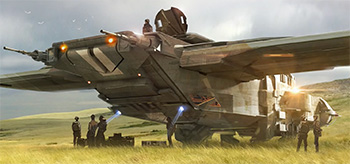Tip #1250: Special Effects in Miniature
… for Visual Effects
Tip #1250: Special Effects in Miniature
Larry Jordan – LarryJordan.com
Models made the difference for The Mandalorian.


This article, written by Mike Maher, first appeared in PremiumBeat.com. This is a summary.
“The Mandalorian” turns to a tried-and-true special effect — hand-crafted miniature models – to create stunning visuals. The Mandalorian’s ship, the Razor Crest, was initially concepted and then modeled in 3D. Small ships were printed for use by the production team to not only finalize the look of the ship, but to help with things like determining the size and layout of the ship itself.
After seeing the number of shots needed and the type of shots, production immediately began on both a physical miniature model of the ship itself, as well as a custom-made motion control rig and track to capture the footage.
The two-foot long Razor Crest model was printed piece by piece in a 3D printer. As soon as parts were completed, they were immediately handed off to John Goodson, who was in charge of assembling the on-camera model.
The 3D printed pieces were so fragile, there was no way they would hold up in construction, let alone on set. The print was fully assembled and then Goodson created a two-piece mold from that initial print.
To capture these miniature shots, ILM CCO and VFX Supervisor John Knoll manufactured a custom motion capture rig and track system in his home garage. A Canon DSLR would be mounted to a custom-made system.
EXTRA CREDIT
The article has more details, images and two videos that go behind the scenes showing how the visual effects of this movie were created.


Leave a Reply
Want to join the discussion?Feel free to contribute!